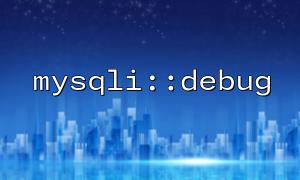Debugging is an important step when using PHP for database operations. mysqli::debug is a very useful function that can help developers output detailed debugging information. However, by default, debug information is output to the browser or log file. If we want to save this debug information to the specified file for subsequent analysis and viewing, we can combine mysqli::debug and fopen() to achieve this.
In this article, we will introduce how to save the debugging information of MySQL database operations to the specified file by using mysqli::debug and fopen() .
First, make sure you have successfully connected to the MySQL database. We will use the mysqli extension to connect. Here is a basic database connection example:
<?php
$servername = "localhost";
$username = "root";
$password = "your_password";
$dbname = "your_database";
// Create a connection
$conn = new mysqli($servername, $username, $password, $dbname);
// Check if the connection is successful
if ($conn->connect_error) {
die("Connection failed: " . $conn->connect_error);
}
?>
The mysqli::debug method allows you to enable MySQL debugging mode and output detailed debugging information. By default, this information is output to the browser's page or to the log file according to PHP configuration.
In order to save debug information to a file, we need to open a file through the fopen() function and write debug information to the file.
First, turn on debug mode:
<?php
// Turn on debug mode
mysqli::$debug = true;
?>
In PHP, we can open a file through the fopen() function and write debug information to the file using the fwrite() function. The following code shows how to implement it:
<?php
// Set the file path of debug output
$debugFile = '/path/to/your/debug_log.txt';
// Open the file for writing
$file = fopen($debugFile, 'a'); // 'a' Mode means appending content to the end of the file
// Check whether the file is successfully opened
if (!$file) {
die("Unable to open the file: $debugFile");
}
// Open MySQL Debug mode and write information to the specified file
mysqli::$debug = true;
mysqli::debug("mysqli debug is enabled");
// Write debug information
fwrite($file, "Debugging information: " . mysqli::debug() . "\n");
// Close the file
fclose($file);
// Close the database connection
$conn->close();
?>
File path : Make sure that the file path you provide for fopen() is valid and that PHP has permission to create or write files in that directory. You can use absolute or relative paths.
File Mode : Using 'a' mode in fopen() ensures that new content is appended to the end of the file instead of overwriting the original content.
The format of debug information : the mysqli::debug() method will return a string by default, containing debug information. You can further format this information as needed.
File permissions : Ensure that the PHP script has permission to write to the specified debug file, especially in production environments. The permissions can be solved by modifying the permissions of the file.
Debug Mode : Care is required when using debug mode in a production environment. Excessive debugging information can cause performance problems and expose sensitive information of the database. Therefore, it is recommended to enable debugging only in development or testing environments.
By using mysqli::debug with fopen() , you can easily save debugging information from the MySQL database to the specified file. This allows easy viewing and analyzing detailed information of database operations, especially in development and debugging.
Hope this article helps you! If you have any questions or suggestions for improvement, please leave a message below.














